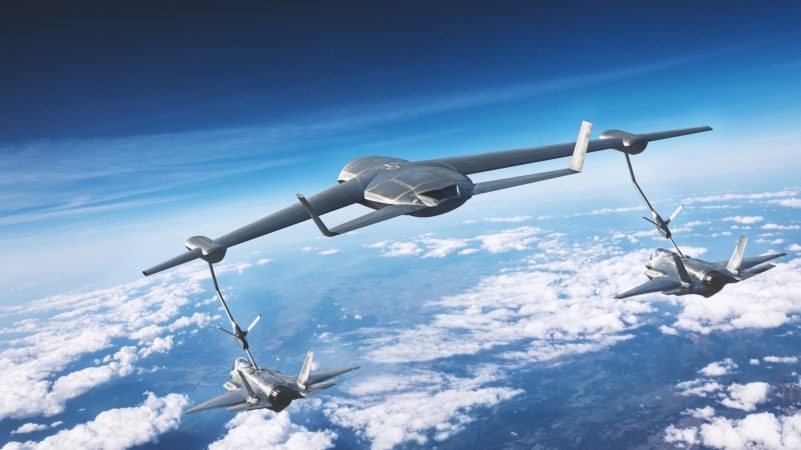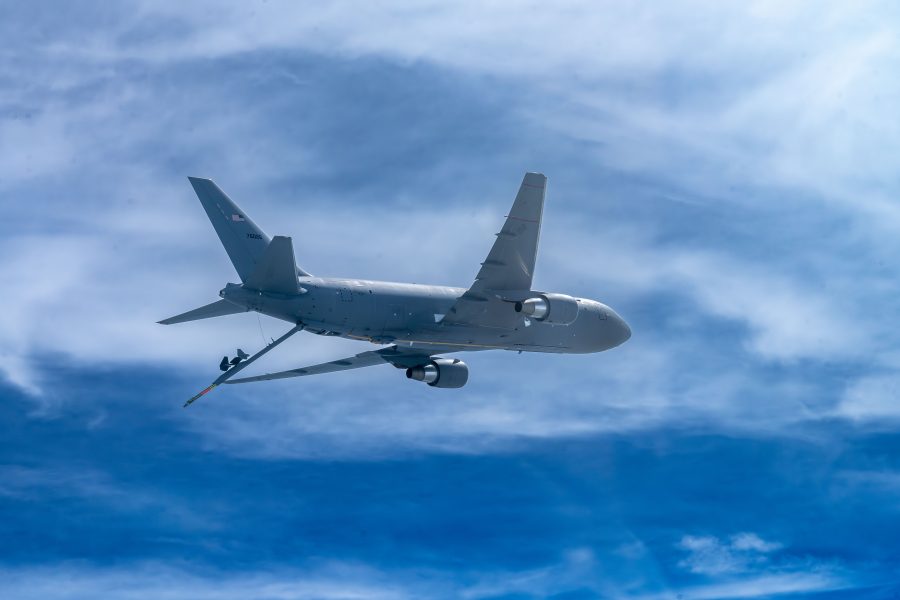The Air Force appears to be leaning buying toward more KC-46 refuelers rather than developing a stealthy future tanker, based on budget documents released this week. USAF’s plans prioritize connectivity upgrades and self-protection measures for its aerial refueling fleet.
No final decisions have been announced, but the budget indicates a “Tanker Production Extension” program to follow the KC-46 once production for those aircraft concludes. That effort is the latest in a series over recent years, which have been dubbed variously KC-Y, Bridge Tanker, and KC-135 Recapitalization. One option has always been to simply buy more KC-46s, possibly with upgraded capabilities; meanwhile, airframe builders Airbus and Embraer have each pitched alternatives.
The 2026 budget outlines “plans to use the KC-46A Capability Production Document as the most affordable requirements basis for Tanker Production Extension.” Doing so would give Boeing and its KC-46 a leg up on the competition, as its offering already meets those requirements.
The Tanker Production Extension program also appears under the KC-46 budget line, rather than a separate line item as was the case for KC-Y, which was listed as Air Refueling Capability Modernization.
“Acquisition strategy approval is anticipated in FY 2025, followed by acquisition documentation development, market research, detailed acquisition planning, RFP development, future tanker development, risk and issue assessment, risk and issue mitigation, and other studies and analysis in FY 2026,” the budget documents state.
Officials are asking for $23.8 million for the Tanker Production Extension project. That’s a sizable increase over the $13.6 million they sought for the predecessor effort in fiscal 2025, but also a major shift from the $188 million the previous administration projected it would spend in 2026.
While work on a potential new tanker isn’t ramping up as much, though, the 2026 budget request doubles down on improving the KC-46—which could make it more appealing to continue production.
Specifically, the Air Force is seeking $81.1 million for capability improvements, up from $58.5 million last year, and $40.4 million for research and development, up from $35.1 million.
Among desired enhancements to the KC-46 are upgraded connectivity and communications, which the Air Force and contractor Boeing have both touted. These include:
- Block 1 Pegasus Advanced Communications Suite: New Link 16 terminals, global beyond-line-of-sight comms, and jam-resistant satellite voice comms for within line-of-sight.
- Block 2 upgrades to enable “compliance with information technology modernization and security requirements [and] integration of the KC-46 on-board information systems with the Joint All-Domain Command and Control (JADC2) architecture.”
- Mobility Air Forces Connectivity, an Air Mobility Command initiative to equip its entire fleet with line-of-sight and beyond-line-of-sight connectivity using a “multi-band, multi-orbit SATCOM terminal and array installation.”
In addition, upgrade funding is still needed to resolve remaining deficiencies with the existing KC-46 design. The Air Force and Boeing continue to revise the aircraft’s Remote Vision System for boom operators, but the budget documents reveal nothing new on that front; they do, however, indicate that “government testing for correction of deficiencies” is expected to continue through at least December 2025.
Work on the KC-46’s Boom Telescope Actuator Redesign is expected to last through the end of fiscal 2027, longer than previously reported. The fix is to adapt the aircraft’s “stiff” boom, which has posed difficulties with refueling the A-10 Thunderbolt II, which has difficulting maintaining sufficient thrust to hold the boom in place. Separately, the Air Force is looking to retire its remaining A-10s in 2026, but the budget documents do not suggest cutting the boom project off if that goes through.
NGAS
Beyond the Tanker Production Extension program, Air Force leaders have spoken of the need for an advanced new tanker, previously called the KC-Z and more recently referred to as the Next-Generation Aerial refueling System, or NGAS.
While the 2026 budget request includes a modest $12.96 million for NGAS, the program appears to be on a slow track, focusing on market research and modeling and simulation to “allow for concept refinement and support to requirements development.”
The idea of building NGAS with some degree of stealth so it can accompany combat aircraft into contested airspace, the new budget documents suggest a changing approach. “Alternatives for more survivable tanking capability could potentially be addressed through more resilient connectivity and on-board and off-board self-protection,” they say. “Acquisition strategies for any or all of these options would be directly related to requirements that will be refined through the FY 2026 activities.”

Former Air Force Secretary Frank Kendall had warned that a stealthy tanker may not be affordable given all of the service’s other priorities, and the new emphasis on resilient connectivity dovetails with planned KC-46 enhancements.
KC-135 Drones
Buried in an infamous 2023 memo from then-AMC commander Gen. Mike Minihan warning of a potential conflict with China was his direction that “KC-135 units will coordinate to provide a conceptual means of air-delivering 100 off-the-shelf size and type UAVs from a single aircraft.”
That concept appears now to be nearing reality, with a KC-135 Drone Delivery Mechanism described as “capable of launching unmanned aerial vehicles from a KC-135 in flight to provide an on-board defensive capability” included in USAF’s fiscal 2026 budget request.
“A prototype integrating a common launch tube with a modified KC-135 aft hatch door to produce and determine the viability of this concept” is cited in the documents. Air Force officials are now “in discussions on best approach to transition the KC-135 Drone Delivery Mechanism to the appropriate [program of record] and implement the capability on the KC-135 fleet,” the document states.
The Pentagon has toyed with the idea of deploying drones from mobility aircraft before—the Defense Advanced Research Projects Agency conceived a program called Gremlins to launch and recover drones from a C-130, and the Air Force has also experimented with palletized cruise missiles that could be launched out of cargo aircraft under project Rapid Dragon. Operational testing for that system is set to conclude this year.


